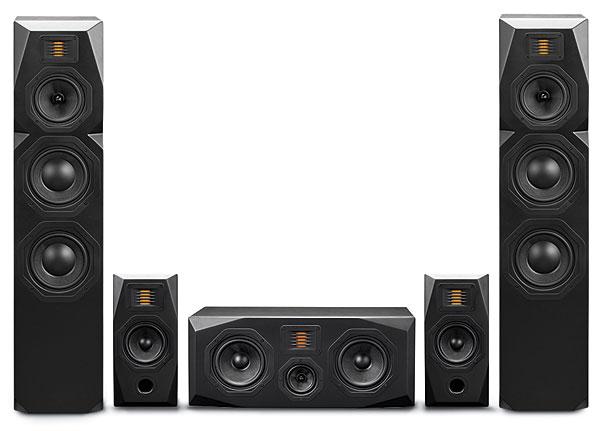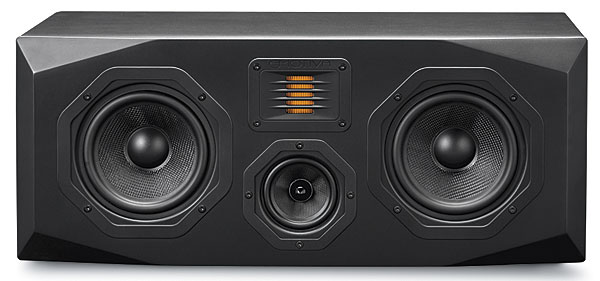Emotiva Airmotiv 5CH Speaker System Review

AT A GLANCE
Plus
Neutral balance with fine imaging
Very good center-channel performance, integration
Superb value
Minus
Towers may require substantial tilt-back
THE VERDICT
Emotiva’s new passive loudspeakers combine serious audio design and refinement with sufficient construction and finish quality to establish unprecedented value.
There’s been plenty of ink spilled, print and digital, in Sound & Vision and elsewhere, about Tennessee’s direct-to-consumer brand Emotiva and the disruptive pricing the company has brought to various audio categories. To date, this has been mostly focused on electronics, where power amps, preamps, pre/pros, and DACs have been offered up for surprisingly small sums that seem to belie their inherent engineering and build quality. Corner company founder Dan Laufman about how he does it, and he’ll enthusiastically share his prior life as an OEM for other audio brands (many of which you know well) and how he’s learned a few tricks about where and how to stretch raw material costs in the most meaningful ways. He’ll go on about the firm’s focus on in-house design. Beyond this, there’s the efficient manufacturing, done domestically at Emotiva’s Nashville headquarters and abroad. Then, there’s the (mostly) web-direct product distribution. But, in the end, it all seems to come down to this: Laufman just doesn’t think good audio kit should cost so much, and he’s willing to sell his widgets for a bit—or a lot—less money, rather than compete directly with likequality products at their higher price points.
That philosophy—indeed, all of the above—is clearly evident in this latest example from Emotiva, a new full-size passive loudspeaker line dubbed Airmotiv, which borrows both the name and some design elements from the company’s professional line of powered studio monitors.
This new range consists of just four models, so far: a three-way mid-tower (T1), smaller (E1) and larger (B1) two-way bookshelves (the former quite low-profile to enhance wall-hang-ability), and a horizontal, three-way center channel (C1). A subwoofer is said to be forthcoming but was not ready for our schedule. All three of the models under review here employ various combinations of 3-, 4-, 5.25-, and 6-inch wovenfiber cones, in combination with the Airmotiv folded-planar magnetic tweeter. This last is yet another variant of the Heil “air-motion transformer” tweeter developed in the late 1960s: An accordion-fold diaphragm is housed in a sort of wave-guide, the audio signal causing the accordion
to “squeeze,” compressing air. The waveguide aims it in a forward direction. (Free-air dipole versions have also been used by other manufacturers, notably ESS Labs.) In recent years, variants of this tweeter design have been cropping up all over, from GoldenEar Technology, MartinLogan, pro-sound label ADAM, budget purveyor Dayton Audio, and more. I don’t know the explanation for certain, but it seems only reasonable to assume that the expiration of patents has been at least one factor in this proliferation. Cost reduction and performance enhancements from modern manufacturing techniques and materials may be involved as well.
Whatever the case, Emotiva shipped us the Airmotiv 5CH bundle, a five-channel suite consisting of T1 and E1 pairs plus a C1 center, for the full S&V treatment. The speakers share similar vinyl-wrap construction, yielding enclosures of reasonable thickness and weight made from high-density fiberboard (HDF) rather than the much more commonly used medium-density variety (MDF). Likewise, they are constructed with internal window bracing, which is said to be mechanically and sonically superior to the more commonly used (and less costly) cross bracing. Each Airmotiv also has a painted HDF baffle/fascia plate that likely performs a useful anti-diffraction function while distinguishing the cabinet at least a bit from countless other black-tower speakers.

Along with the aforementioned tweeter, which appears to be identical in all three models, the cabinets are populated with reassuringly weighty drivers attached with machine screws and inserts rather than the usual wood screws, and decent, heavy-duty crossovers; these are all designed in-house by Emotiva. The E1, destined for surround use, does make a compromise by employing push terminals—a choice I abhor but can understand in what is, after all, a $229/pair loudspeaker. The other models get inexpensive but solid multi-way terminals, doubled and linked for biwiring. Or as I like to call it, “buy-wiring.” Black-knit, magnetfixed grilles are supplied all around. They didn’t seem to impose materially on the sound of any model, but as is my usual practice, I did all my listening with the grilles removed—which, revealing the sculpted front, gave the speakers’ look a bit of a stealth-fighter/Darth Vader scowl.
I arrayed the Airmotivs in my usual locations: the T1 towers astride my still-newish 55-inch 4K screen, the C1 center on a low stand just kissing the screen’s bottom edge, and the E1 surrounds on my high shelves flanking the listening position, a foot or so behind but angled inward to wash along the side walls. Lacking an Airmotiv subwoofer, I pressed on with my everyday sub, the not insubstantial SVS PC12-Plus. With the speakers roughly placed and confirmed to be making noise all around, I left them alone for a few days of break-in via casual TV viewing and overnight all-channels-stereo net-radio airplay.
Let the Listening Begin
For my first serious listening session, featuring full-range stereo (no subwoofer) music via the towers alone, I cranked up my Oppo BDP-105D’s DLNA streamer and went to work. The prejudice engine of my subconscious always wants to draw attention to the treble of any speaker with a different-looking tweeter, but the T1s gave no hint of their exotic (or, at least, less common) highfrequency drivers. In fact, I found the towers’ overall balance to be almost perfectly neutral.
However, I quickly determined two other facts. First, like most other full-range floor towers placed too close to the front wall, the T1s could sound distinctly “tubby.” Repositioning them for nearly 4 feet of open air between their baffles and the wall eliminated this. Second, the towers’ vertical sweet-spot appears fairly low and in a moderately narrow vertical window. Even when the speakers were on the supplied screw-in spikes, I had to hunch down a good 6 inches to experience full treble openness and sparkle, which I addressed by tilting the speakers back perhaps 10 degrees or so. I used CD jewel cases for easily adjustable lifts, but the same effect is more permanently available by screwing the front spikes all the way out and the rear spikes all the way in, which should just about achieve the same angle. (After writing the above, I remembered that my phone has a level function. The actual tilt measured a bit less than 6 degrees, so obviously my internal protractor is an inveterate exaggerator.)






























































